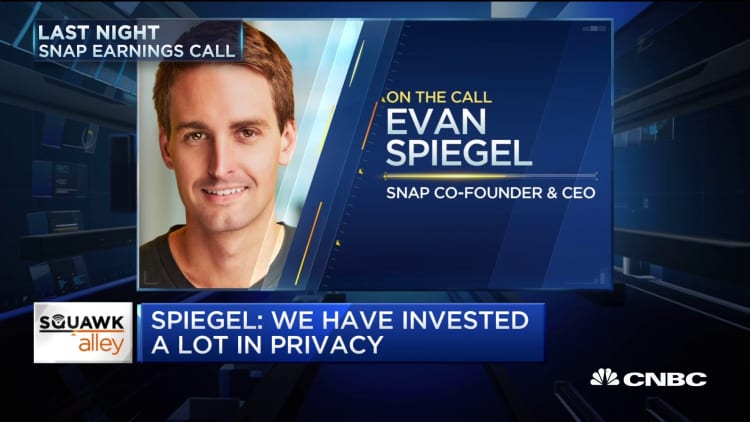When Snap hosted an invite-only Partner Summit in Los Angeles in April, it was a chance for advertisers to see what the social media company had in store for the months ahead, like a new audience network and a gaming platform.
But for advertisers in attendance, it had a deeper meaning too.
The event "definitely showed a change in their approach to advertisers," said Cliff Atkinson, a senior vice president and executive director of digital media at ad agency RPA. "To share these types of new innovative opportunities with advertisers, it showed more of a willingness to share and be a little more personal with the advertising community."
"I've seen them present or share their shows at [events like] the Newfronts, but this was very different from that," he continued. "It was more visionary in regards to, 'This is how we're moving the company forward,' versus, 'Here's a few shows we're going to be launching if you guys want to be part of it, great.'"
For Atkinson, the event had one Snap exec's name written all over it: Jeremi Gorman, who was hired away from Amazon last year as chief business officer to replace part of the role vacated by Imran Khan.
Snap CEO Evan Spiegel announced the appointment in October. Gorman, he told employees, would take charge of the social network's global business solutions, global online sales, customer operations and business marketing. Upon the news that Gorman and Chief Strategy Officer Jared Grusd were coming aboard, Snap shares immediately reacted, rising as much as 2%.
Gorman stepped in after a rough two years post-IPO for Snap, with its user base shrinking from 191 million daily users in the first quarter of 2018 to 188 million the following quarter. That seems to be seeing a turnaround. During the second quarter, Snap's user base grew to 203 million daily active users, making it the second quarter in a row of growth for the company. The company's stock as of Thursday was $17.17, 356% up from the company's lowest in the past 52 weeks.
eMarketer expects Snapchat to generate $1.36 billion in net worldwide ad revenue this year, a 30% increase over 2018, giving the company a 0.4% share of the worldwide digital ad market.
New products and ad formats have driven some of that growth: The company's lenses are popular ways for users to see what they'd look like as a person of the opposite sex or as a baby. It's also given advertisers more opportunities to reach those users, including through Snap Select, which lets brands run non-skip commercials on the part of the Snapchat app that has shows. Gorman said on last week's earnings call the company had more ad accounts active in the second quarter than ever before. The platform has also made strides in ad tech, adding spend from direct-response advertisers as one result.
Advertisers who work with Snap are seeing the momentum. Several ad industry insiders who spoke to CNBC said Gorman's strong reputation at Amazon preceded her as someone who's able to drive the sales organization at a large corporation to success. During the company's strong second-quarter earnings last week, Gorman was featured prominently.
She spoke of the company's intention to increase the number of active advertisers using Snapchat to grow revenue, and told investors the company's self-serve augmented reality tool has been scaling quickly. She outlined case studies with "Game of Thrones," Subway and the oral care brand Quip. She said the company had completed its sales reorganization in the U.S. And she finished with somewhat of a zinger stat: In the second quarter of 2019, North America year-over-year average revenue per user growth rate was 42% — its highest growth rate since the second quarter of 2017.
Gorman joined Snap from Amazon, where she was most recently the head of global field sales. Though her tenure at Snap is still young, advertisers told CNBC that her mark on the social media company is already undeniable.
"You've seen the company's market cap triple in the time she has been there," says MediaLink CEO Michael Kassan, who has worked with Gorman in her time so far at Snap. "Now, she can't take 100% of the credit, of course." But Gorman came in at a "really tough time" and brought both sensibility and an art that was needed to help the company, with having product and advertising work hand-in-hand, Kassan said. "She also brought the business acumen and the business process that they needed."
Agency leaders who have worked with Gorman's team at Snap said she has reorganized sales in a more specialized, intuitive format that makes it easier for advertisers to work with Snap team members. They said Snap has become simpler, more navigable and friendlier to partners and advertisers under her wing.
"She has a real appreciation for and sort of an empathy for the marketers that are using the Snap platform," said Alex Collmer, CEO of video creation platform Vidmob. "I think she does a great job of listening to them and hearing what they need to be successful and translating that back to the Snap business unit and make sure it's built and delivered."
Snap declined to make Gorman available for an interview.

'The same hymn book'
Many in the ad industry said the most noticeable change during Gorman's tenure so far is the way Snap positions itself to the outside world. Where Snap once claimed its audience was everyone, the platform has leaned hard into its core user base of Gen Z.
Advertisers said they appreciate it.
"They were selling to us that Snapchat was, 'Hey, you could reach everybody.' Everybody knew that really wasn't the case," said Jim Cridlin, global head of innovation and partnerships at media agency Mindshare.
Instead of saying advertisers don't need Facebook, Snap recently has changed its tune.
"They've realized, 'We're not going to sell that way. The story we can tell is the incremental reach we can bring to those other platforms,'" Cridlin said. "Focusing on Gen Z and acknowledging that's where their strength is has helped media buyers get their head around where Snap fits … They've been a lot more honest."
Noah Mallin, head of experience, content and sponsorship at media agency Wavemaker, sees it a similar way. Though he said the industry seemed to be looking for a new alternative to Facebook and Google, he said companies like Twitter and Snap have tried to be that alternative before learning to stick to where they're successful.
"I think she's responsible for making sure that everybody is singing out of the same hymnbook … It gives them a clearer story," he said of Gorman. Even without the massive scale of Facebook or Google, Mallin said Snap now points to other metrics like time spent in Snapchat since its users often spend time in other competing apps too.
"The idea that [users] value Snap in a different way allows them to have a much clearer message. I think [Gorman is] certainly responsible for that," Mallin said.
Of course, Gorman hasn't done it alone. She has also surrounded herself with a team of figures that are well-known to the advertising community.
One example is Dave Roter, who at one point had a similar role at Twitter as a senior director for video sales and agency development. He's now the company's VP of global agency relationships. Gorman also promoted Luke Kallis to the role of vice president of enterprise sales in the U.S. Other major players on the team include Claire Valoti, who handles international sales; Radhika Kakkar, VP of operations and online sales; and Dominic Rioux, hired from Amazon as a vice president of emerging accounts. Another major hire is Craig Stimmell, Procter & Gamble's head of media and partnerships, who will soon join Snap as its head of brand partnerships, Business Insider reported this week.
Sales team
Gorman said in her second-quarter earnings remarks that she was finished with the sales team reorganization in the U.S., crediting one successful campaign with that reorganization.
"[An] HBO Now campaign implemented our Snap Pixel to help drive high-quality conversions, making us one of HBO's most performant acquisition channels of 2019," she said "This deep partnership was made possible by our recent sales team verticalization."
The "verticalization" meant pivoting from a more regional structure to one that focuses on categories like enterprise or direct-response clients, a way "so that Snap team members become deep experts in their partners' businesses and industries," Gorman said on Snap's Q4 2018 call.
That's been a positive for advertisers who recall the company being difficult to navigate before Gorman came aboard.
"It's been a very confusing proposition for agencies and clients to just understand but also as an organization to kind of deal with," Cridlin said. He said the organization under Gorman has made the internal structure better for advertisers.
Meghan Myszkowski, VP of social activation in North America for media agency Essence, said under Gorman, the roles of sales reps make a lot more sense for the advertisers working with them.
Myszkowski said an early change was to lay in an "Amazon-esque structure," now with reps with more specific knowledge of certain areas. She said this makes them more deeply knowledgeable of that particular area, and reps aren't spread as thin as they were before.
Next challenges
Snap seems to have some good positive momentum. The key will be to keep it going. Mindshare's Cridlin said one key will be elbowing away players like TikTok that are making gains in Snap's core audience.
"How do they keep Snapchat users engaged?" he said.
Another conversation will be how advertisers balance Snap's targeting, which has erred on the side of conservative when compared with something like Facebook.
"They've always been really closed with their data," said Pete Stein, CEO of digital agency Huge. "In terms of targeting, they let you target demos, but you don't know exactly the segments they've created, you don't know what behaviors are creating the segments … they're giving more reporting data in terms of what's working. They err on the side of caution in terms of sharing" that kind of reporting data back to advertisers.
Snap says its more than 500 predefined audiences are built using Snapchat and third-party data and let advertisers reach people based on online and "real world" interests and behaviors.
Atkinson said for these uncertain times, that might be okay to ride out.
"Of course we want as [many] targeting opportunities as possible, but we are moving into this new world where privacy is of the utmost importance, and I think Snap is smart in how they're trying to tackle it," Atkinson said.
Essence's Myszkowski said she wouldn't mind seeing Snap slow down slightly to see how all these changes are shaking out.
"I know that Snap has always been running a thousand miles a minute. I think right now is a good time for them to stop, pause, see how things are working," Myszkowski said.



